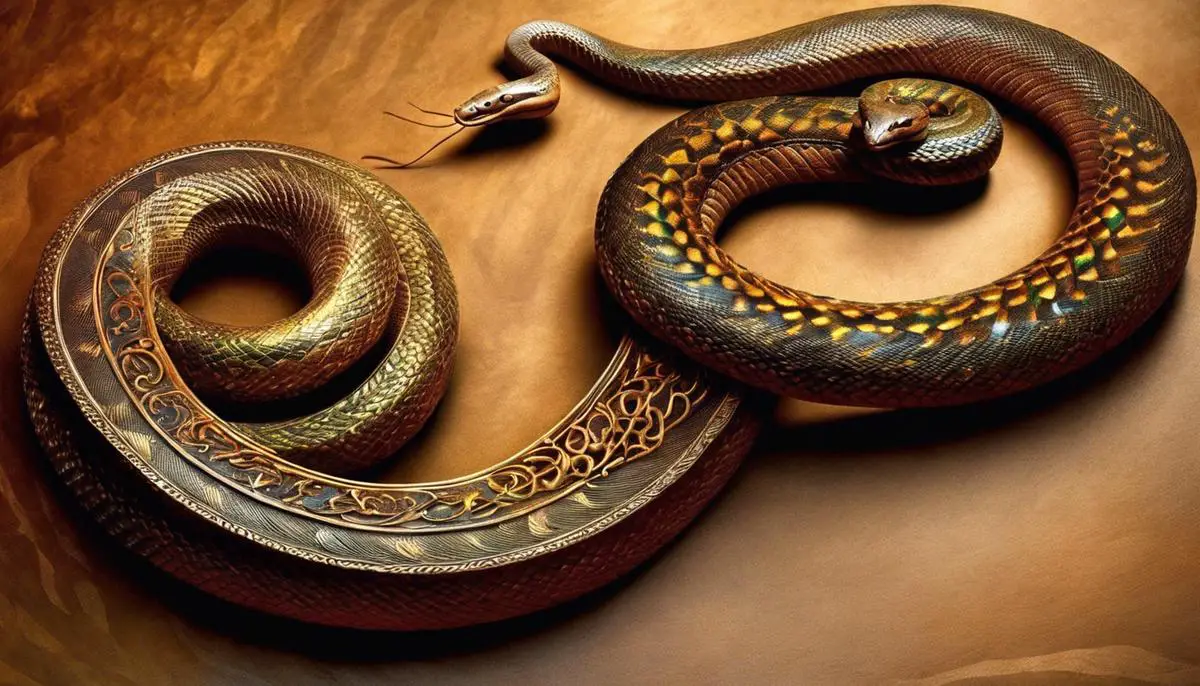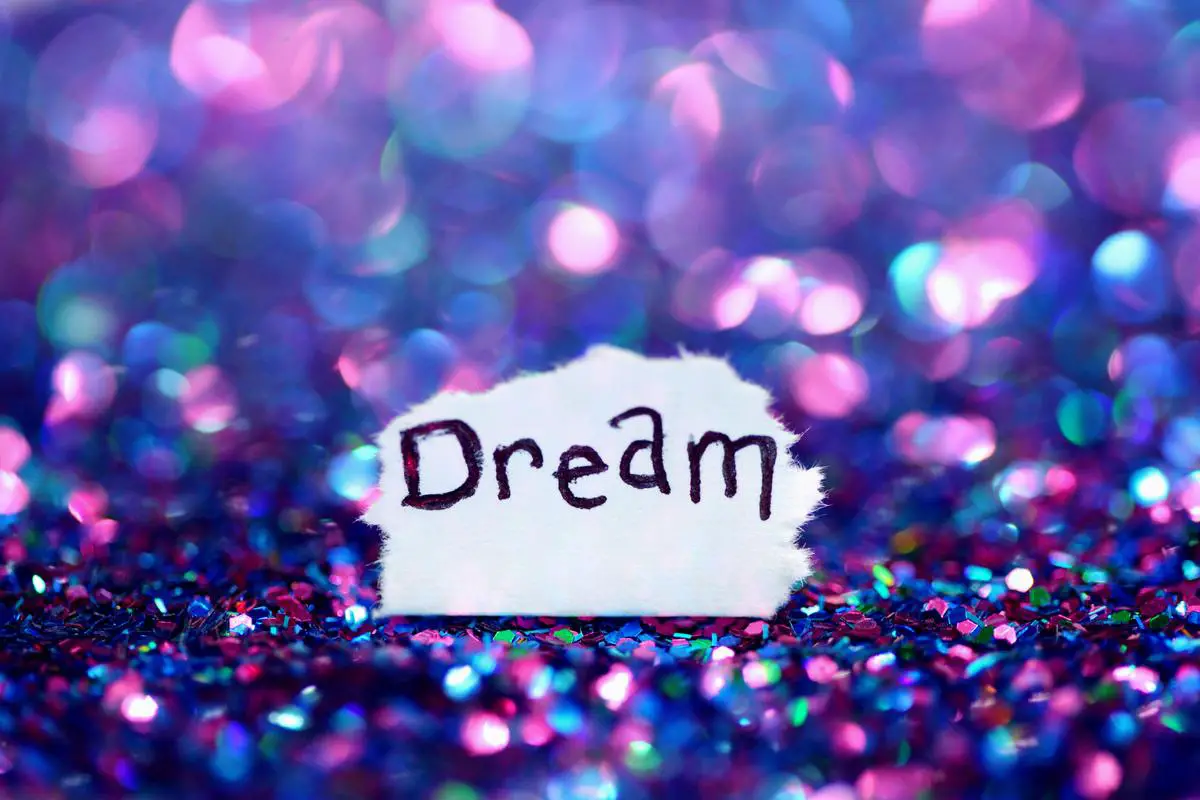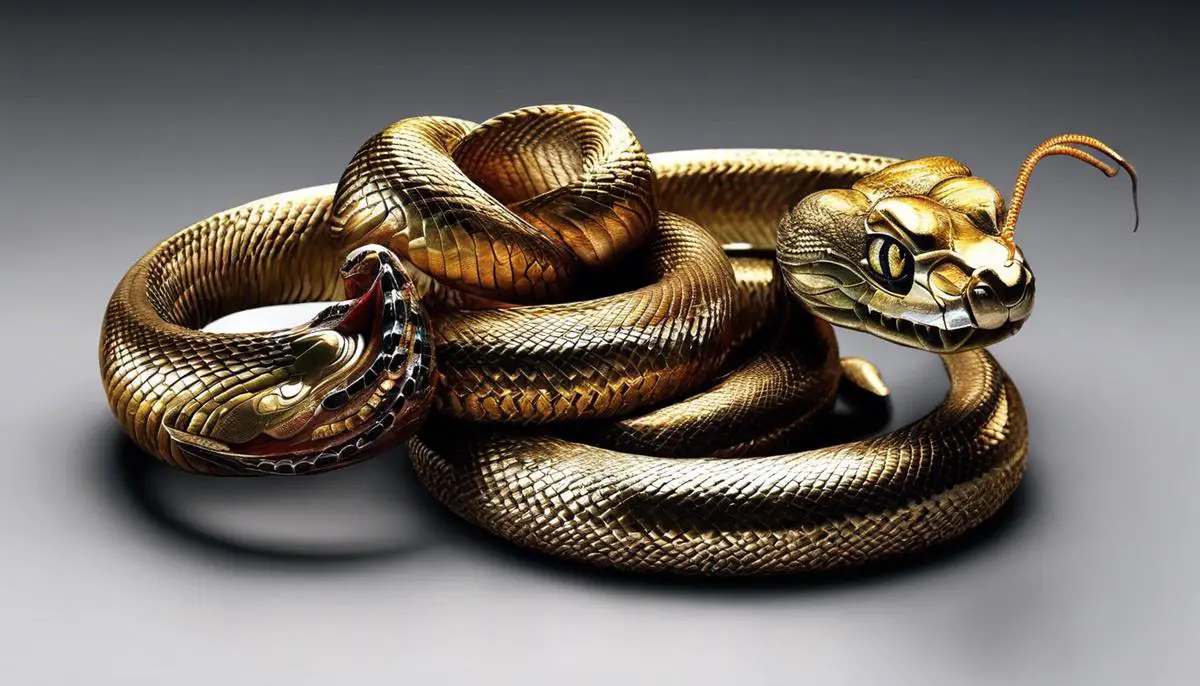In the expansive world of Vedic lore, few symbols carry as much ambiguity and rich symbolism as the snake. Revered for its power, stealth, and instinctive nature, it has found its way into legends, myths, and dreams, acting as a potent harbinger of profound personal and spiritual transformation. This article sheds light on the powerful symbolism of snakes within Vedic literature and philosophy while delving into the nuances of dream interpretation within this rich tradition. Straddling the worlds of symbolism, spirituality, and dreams, we unravel the meaning of being bitten by a snake in dreams, underlaying it with the principles of Vedic philosophy and its interpretation of dreams.
Symbolic Significance of Snakes in Vedic Literature
Deep inside the hallowed strata of ancient Vedic literature, there dwell countless symbols marinated in a rich cultural, historical, and philosophical context. It’s an archive of wisdom that has challenged the best minds across centuries, sparking intense discussions, debates, and interpretations. Among the myriad of ancient symbols found in Vedic lore, the snake possesses a particular grandeur, displaying its multifaceted persona throughout the array of epics, Upanishads, Puranas, and other spiritual texts.
Snakes hold a complex web of symbolic attributions within these rich, ancient resources. A primary embodiment of death, rebirth, and immortality, they anchor themselves firmly to the primal energies of existence. On an elemental level, Vedanta attributes snake to water, thereby underscoring the creature’s intrinsic volatility and instability—a signifying wave of life, death, and rebirth. Often associated with Sheshnag, the serpent king who represents the infinite realities of existence, the prominence of snakes alludes to the vast scope of the cosmic continuum.
In the multifaceted universe of Hindu mythology, the snake bears a harmonious dualism. It is a tangible symbol of fear and threat, with venomous fangs that epitomize danger, sin, and enmity. Yet, simultaneously, it exudes spirituality, cryptically entwined around the neck of Lord Shiva—the destroyer and regenerator of the universe. This paradoxical nature mirrors the duality of life, a reflection of the amalgam of contrary forces that govern the universe.
Far from being merely symbolic, snakes in Vedic scriptures also embody personified figures. Nāgas, considered celestial semi-divine beings, often manifest themselves in the physical form of serpents. Legends recount stories of their divine cities, abundant wealth, and mystical powers, while in more metaphysical interpretations, Nāgas are considered guardians of the spiritual underworld and keepers of sacred wisdom.
Connecting this ancient symbology to a broader and more practical framework, the Kundalini Yoga – a significant spiritual discipline, employs the serpent metaphor to illustrate the process of spiritual awakening within the human body. The coiled serpentine energy at the base of the spine represents dormant potential, which upon waking travels up through the energy channels, leading to spiritual enlightenment and liberation—the ultimate quest in life.
Generally feared and revered in equal measure, snakes possess a curious charm that has intrigued and beguiled scholars, practitioners, and casual observers alike for centuries. Their dichotomous representation in Vedic literature—as harbingers of fear and danger, yet also as guardians of celestial wisdom and tokens of spiritual awakening—resonates deeply with the multifaceted, intricate, and ambivalent nature of life itself. Through them, the Vedic tradition imparts profound insights into the complexities of existence and consciousness, offering valuable introspection into our quest for knowledge, wisdom, and liberation. This encounter with the serpent symbol in ancient Vedic scriptures is a testament to the enduring richness and depth of the human spiritual journey.

Interpretation of Dreams according to Vedic Philosophy
Delving further into the fascinating study of Vedic philosophy untouched by previous discourse, the realm of dreams offers unparalleled insights. Dreams, according to the Vedic worldview, serve as a mystic portal between the empirical world of sensory experience and an ethereal dimension unfettered by physical constraints.
In order to understand the Vedic view of dreams, it’s imperative to discern its tripartite conception of the universe. The cosmos, according to this philosophy, bifurcates into three regions: the waking world (Jagrat), the dream world (Swapna) and the deep sleep phase (Sushupti). Each of these spheres holds relevant implications in the pathway towards enlightenment, with specific Enneads of the Upanishads dedicated to their thorough exploration.
Dreams, occupying the domain of Swapna, refashion the sensory impressions of the waking state into multitudinous symbolic forms. Animating the landscape of this realm are vivid and enthralling manifestations that carry deep metaphorical implications, much like the omnipresent snake motif explored previously.
Furthermore, the exploration of dreams in Vedic traditions follows two broad interpretative paths: psychological and spiritual. The psychological analyzes dreams as a mental activity, essentially a byproduct of the psycho-physiological processes. The spiritual interpretation, on the other hand, views dreams as precursors to spiritual enlightenment, a perspective that aligns with the overarching spiritual tenets of Vedic philosophy.
Interestingly, the spiritual interpretation of dreams mirrors the concept of Nāgas as guardians of celestial wisdom. Just as the Nāgas safeguard spiritual wisdom hidden deep under the water, the potential for spiritual awakening rests subtly beneath the dream experience, awaiting the moment of conscious awareness.
Specifically, this spiritual interpretation is encapsulated in the teachings of Swami Rama. Dreams, according to Rama, are examples of the mind’s capacity to manifest images from a subtle world. The key lies in harnessing this capacity not just during sleep, but while fully awake. Herein lies the allusion to Kundalini Yoga’s serpent metaphor, as conscious dreaming necessitates the awakening of the Kundalini serpent lying dormant at the base of the human spine.
The exploration and understanding of dreams in the Vedic tradition thus takes us on a journey of self-discovery and spiritual enlightenment. Acknowledging the richness of this journey in its entirety extends an invitation to explore personal depths, offering insights not merely into our slumbering psyche, but the expanse of our innate spiritual potential as well.

Photo by sharonmccutcheon on Unsplash
Interpretation of Snake Bites in Dreams
Delving deeper into the theme of snakebites in dreams according to Vedic interpretation, it’s crucial to highlight the important role these serpentine dream encounters play. A snakebite, a direct interaction between the dreamer and the snake, can be seen as a significant spiritual interaction or message.
Dreams, comprehended as a unique state of consciousness in the Vedic perspective, are viewed as fundamental channels through which the subtle layers of the individual’s mind are accessed. Therefore, snakebites in dreams are not dismissive, haphazardly composed illusions of the sleeping mind, but are considered meaningful symbols carrying profound metaphysical insights.
From a Vedic standpoint, a dream about being bitten by a snake potentially indicates an impending transformation or a spiritual awakening. The poison transferred in the bite is not usually seen as deleterious but viewed metaphorically as an essential pharmaceutical agent to stimulate the anticipated change. The poison signifies the purgative function, a spiritual detox designed to purge the personality of spiritual impediments and karmic burdens.
Dreams of snakebites should therefore be assessed in terms of the dreamer’s subconscious projections, reflective of deep-seated existential anxieties and spiritual predicaments. In the Vedic tradition, recurring dreams of snakebites specifically are often ascribed to the activation of the primal energy of Kundalini, which is symbolized as a coiled serpent power dormant at the base of the spine.
The dreamer’s interaction with the snake, which culminates in a bite, can therefore, be perceived as an initiation into an intense phase of spiritual evolution. From this perspective, a snakebite is a transformative event, demanding an introspective search for renewal and rebirth.
In conclusion, interpreting snakebite dreams within the Vedic tradition demands a highly nuanced understanding of the profound symbolism of snakes, the Vedic philosophy of dreams, and a comprehensive insight into the multi-dimensional spiritual landscape of the dreamer. These dreams provoke a reevaluation of the individual’s life path and personal transformation, instigating profound introspection, and providing an unique opportunity for spiritual development and growth.

Cross-Cultural Comparison of Snake Bite Dream Interpretations
Fuse this with the universal symbol of the serpent across various cultures, a symbol entrenched within the collective human psyche, and we have a fascinating exploration of the interconnectedness of our global human narrative.
The cosmological narrative of many indigenous American cultures, for instance, features serpent deities as bringers of wisdom and change, echoing the dual symbolic nature of snakes in Vedic lore. A dream of a snake bite could be interpreted as impending profound changes or a call for the dreamer to evolve, similar to the Vedic interpretation.
Denoting wisdom and transformation, snake dreams in the Native American tradition might consider snakebite dreams as warnings or precursors of tests on the path of personal growth. For them, the snake, especially rattlesnakes, symbolize cycle of death and rebirth, similar to their Vedic counterparts. There is also the mythology of the plumed serpent deity Quetzalcoatl in Pre-Columbian Mesoamerica, revered as the boundary crosser, which hints at a parallel spiritual awakening.
In Ancient Egyptian culture, snake bites in dreams could signify divine providence or signify the workings of a primal force. Snakes are representative of both chaos and unity, mirrored in their portrayal of the serpent deity Apep and their worship of the cobra-goddess Wadjet. There is a sense of fierce protectiveness and divine wrath captured in these depictions, which ties in with the Vedic idea of Nāgas as guardians of wisdom. Additionally, the Uraeus, a stylized upright form of an Egyptian spitting cobra, used as a symbol of sovereignty, royalty, deity and divine authority, resonates with the Kundalini awakening in Vedic philosophy.
Drawn from the wellspring of collective human subconscious, dreams of snake bites in various cultures serve as a call to explore the inner self, echoing the Vedic philosophy’s emphasis on internal exploration as a means to spiritual awakening.
In Greek mythology, the Rod of Asclepius, a serpent-entwined rod wielded by the Greek god Asclepius, represents healing and rejuvenation, which aligns with the Vedic interpretation of the snakebite’ healing or purgative properties. This sends a trans-cultural message of poison-as-medicine, aligning with the metaphorical interpretation of poison as a purgative function for spiritual detox within the Vedic tradition.
In a Jungian context, Carl Jung’s postulations on the symbolic representations of archetypes reflect in the interpretations of snake dreams. According to Jungian psychology, such dreams can represent instinctual drives and could reveal conflict between one’s conscious attitudes and repressed instinctual drives, a concept not too far off from the Vedic interpretation of snakebites as indicators of deep-seated existential anxieties and spiritual predicaments.
Overall, despite the vast geographic and cultural landscapes that separate these belief systems, there is a distinct overlay of meanings that echo the same sentiments of wisdom, transformation, and spiritual awakening. In its construct, the symbolism of the snake and snakebite dreams showcases the universal quality of human contemplation of the seen and unseen realms, life, death, rebirth, and the uncanny journey of spiritual evolution.
By providing a comprehensive presentation of the snake motif within Vedic literature, dream interpretation and philosophy, this discussion enlightens on the profound meanings and impacts a snake bite dream can potentially hold. In extension, the article explores a cross-cultural comparison of snake bites as dream symbols, assessing their significance through a multitude of prisms from Jungian psychology to various indigenous religions. Thus, offering a truly global perspective on this shared human experience, it acknowledges the common threads that link these diverse interpretations while honoring the distinct nuances each tradition brings to light. A dream of a snake bite, as it surfaces, is a profound kaleidoscope of transformation, wisdom, and potential spiritual growth, a universally intriguing, deeply personal experience, refracted through the lens of cultural and spiritual diversity.
